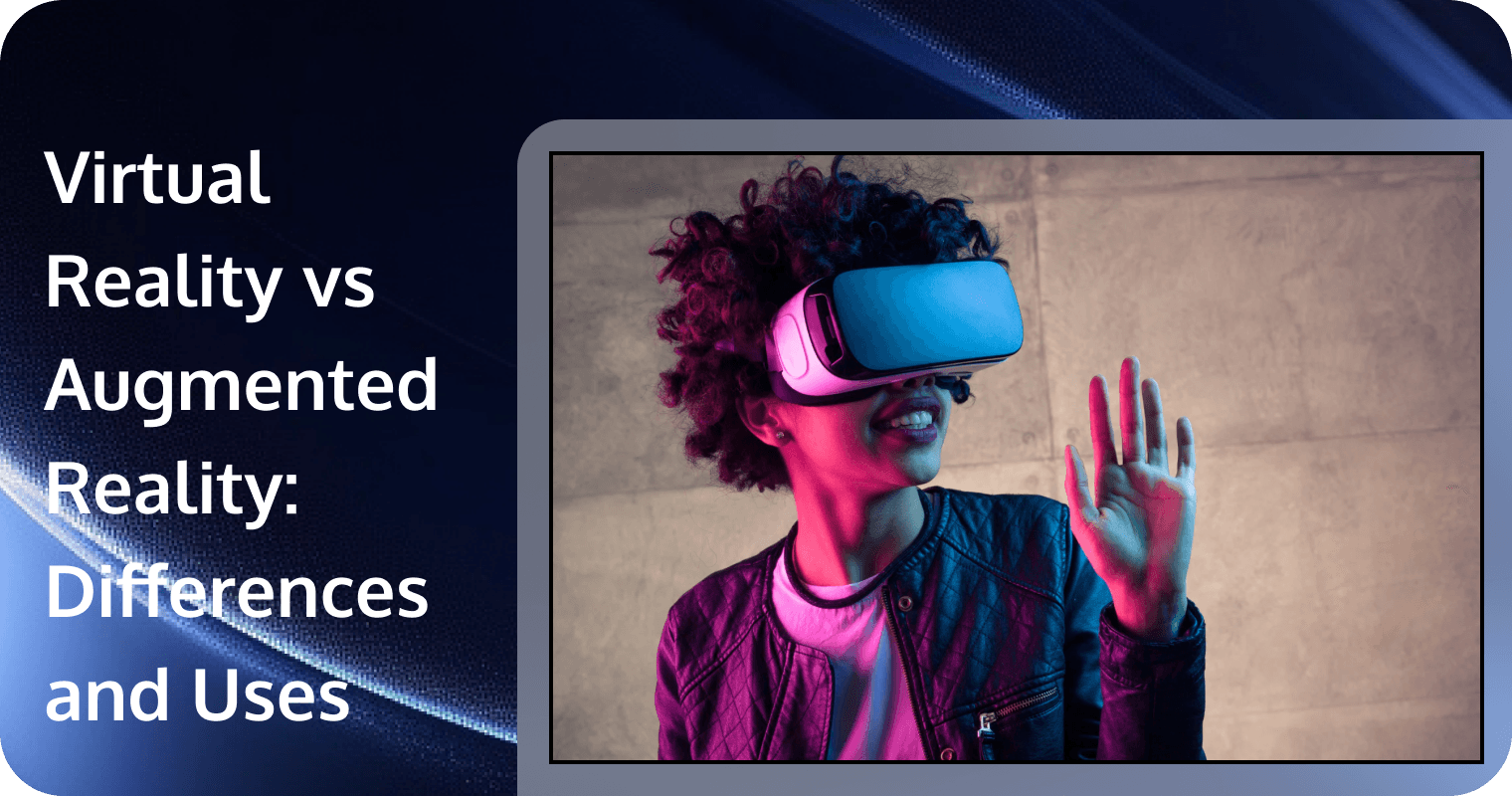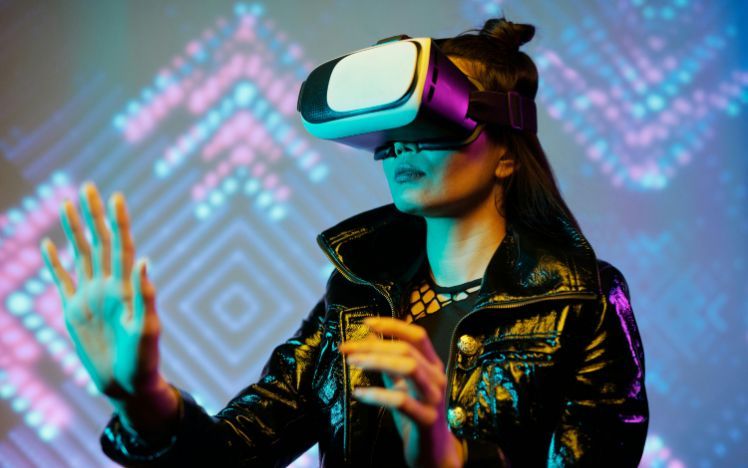 Virtual Reality vs Augmented Reality: What’s the Difference
Virtual Reality vs Augmented Reality: What’s the Difference
Confused about the difference between augmented vs virtual reality? These two hottest technologies are often mistaken to be the same, yet they’re actually different. Understanding their differences and applications in everyday life is essential. Virtual reality (VR) and augmented reality (AR) are slowly changing how we see the world as they push the walls of the real world and build a bridge toward the virtual world. In this guide, let us explore how they drive humans to reimagine the normal way of life.

Alt: VR headset
What is Virtual Reality?
Virtual reality detaches you from the real world and takes you into a different world. This digital experience primarily requires using VR headsets or special glasses. When you put on the headset covering your eyes, the real world around you is replaced by an imaginary world. This made-up world also seems so realistic that you might forget you’re just standing in your room.
This technology is commonly used for immersive virtual gaming. For example, if you play using VR glasses, you feel like you’re inside the screen of a gaming app you used to play and you can interact with virtual objects around you. Today, VR reaches its influence in different fields such as virtual tourism, training simulations, and remote collaboration.
What is Augmented Reality?
Augmented reality does not take you into a different world. Instead, it allows you to add fun and cool things to the real world you’re already in by overlaying information or graphics on your view. AR is usually experienced through phones or tablets. One of the popular examples of AR using a phone is Pokemon Go, a game app that allows you to see creatures and catch them in real-world locations.
AR has also dedicated special glasses. Unlike VR headsets that completely block your view and replace your world, AR glasses let you see both the real world and virtual enhancements on your screen at the same time. AR is commonly used for practical applications, such as virtual try-ons in online shopping, route navigation, healthcare, and live streaming interaction.
Alt: Pokemon go app
Differences Between Virtual Reality and Augmented Reality
Virtual reality and augmented reality both offer immersive digital experiences. However, they differ significantly in how they operate and are used. Let’s compare virtual reality vs augmented reality:
·User Interaction: VR makes the user disappear in the real world and live inside an imaginary world. AR enhances your real world by overlaying floating virtual objects that can be manipulated using touchscreens, voice commands, or hand gestures.
·Immersion Level: VR provides a fully immersive experience in a virtual world and complete disconnection from the physical world. AR provides only a limited immersive experience because it allows users to interact with both the real world and virtual enhancements.
·Mobility: VR restricts your movement while immersed in a new world. You should stay within a designated space to avoid collisions with your physical environment. AR allows you to move freely while interacting with the virtual elements you see in the physical world. You can go outside your home to find Pokemon or take your phone anywhere when using Snapchat.
·Hardware Needs: VR can be experienced only using specialized headsets with controllers for interaction. An example of VR headsets is the PlayStation VR glasses. AR is flexible and more accessible as it can be experienced using phones, tablets, and special glasses. An example of AR glasses is the Microsoft HoloLens.
·Environment: VR lets you hear the most realistic sounds and see HD-quality graphics of the unreal digital world through hand controllers, body-tracking, or voice commands. AR does not change your environment while interacting with virtual enhancements using your phone or special glasses.
Alt: VR goggles
Applications and Use Cases of Virtual Reality
The power of virtual reality is not just caged with immersive gaming. VR headsets are taking other industries into a magical world where people can learn and work. Here are some popular applications of VR:
1. Entertainment
VR first became well-known in the field of gaming. A popular example of this is playing with a PlayStation console. Once you wear the VR headset, you’ll begin an immersive journey inside a 3D virtual world where you become part of the game instead of just looking at a screen. You can run in a jungle, avoid obstacles, or hear your footsteps. This is all possible because of virtual reality.
2. Education
Physical classrooms are more exciting with the integration of virtual reality. Imagine students exploring the solar system without leaving their classroom. Medical students also use VR to practice surgeries before operating on real patients. Pilots use VR when learning to fly planes before touching real planes. These are all examples of practicing real-life scenarios without giving a chance for real-life mistakes.
3. Virtual Meetings
As remote work is becoming a trend, companies can hire different talents from different locations. The problem is how to connect your team in one place. With VR, it creates virtual offices where members can virtually meet and work together as if they’re just sitting at one table. VR levels up the experience by bringing everyone together in a 3D virtual room instead of just relying on traditional video calls.
4. Virtual Tourism
Before, visiting a foreign destination sounds impossible because of your limited resources. Today, you can virtually visit a popular tourist spot without spending a dime and leaving home. For example, you can virtually walk through the streets of Paris or explore the pyramids of Egypt. Instead of looking at boring photos your teacher shows you in the classroom, VR can take you virtually to actual destinations.
Alt: Girl wearing VR box
Applications and Use Cases of Augmented Reality
Augmented reality is more exposed to people because of its availability in mobile phones. AR may not take you to a different world, but it is improving the normal activities we perform in our daily lives whether we’re driving, communicating, shopping, or saving lives. Here are some of the real-life applications of AR:
1. Live Streaming
Live streaming platforms use built-in AR tools like TRTC live tool to enable live audience interaction. AR fans can interact with their favorite gamers by displaying their comments and virtual gifts. For live shopping, AR can add a Try-On button for customers during the live broadcast of online sellers. For entertainment, celebrities may use AR to apply face filters while interacting with their fans during Instagram live streams.
2. Navigation
Afraid of getting lost in an unfamiliar place? AR is used to provide real-world assistance, making navigation easier by overlaying the digital directions you need while driving. For example, when you’re driving a car and don’t know the way to your destination, Google Maps on phone screens uses AR to lead you to the right routes.
3. Retail and Shopping
AR is also changing the way we shop. For example, shopping sites that use AR tools like the Tencent Real-Time Communication’s WebAR Try-On allow businesses to integrate AR on their websites. Thus, customers can try on clothes in virtual fitting rooms, try sunglasses virtually, or test how furniture will look in their living room. This enhances the shopping experience for customers before they make online purchase commitments.
4. Healthcare
AR is helping to save lives in the field of healthcare. Doctors use AR to see what is inside the human body. Through medical scans, surgeons can see the 3D models of human organs before performing operations. AR guides doctors to make the right diagnosis, promoting accuracy and efficiency while reducing risks in surgical missions.
Conclusion
Virtual reality and augmented reality are making the real world exciting. While VR takes different industries to a new world to learn and work, AR is helping industries to thrive without detaching from the real world. Understanding their differences and applications is important as they are already making changes in our daily activities. In a world that is becoming more digital, it depends on you if you refuse or not to get left behind.
FAQs
What is the main difference between virtual reality and augmented reality?
Virtual reality replaces the real world with a digital world where you can completely interact with the virtual objects around you. Augmented reality enhances your real-world through overlaying digital information or graphics on your view.
What is an example of AR and VR?
An example of VR is playing on a PlayStation console. When you wear its VR headset, you become the player inside a digital world and interact with the virtual objects and surroundings you see. An example of AR is the Ikea Place app. This app provides a virtual try-on to see how Ikea furniture will look in your living room.
Is Pokemon Go AR or VR?
Pokemon Go is an example of augmented reality. When you open your camera, you can see virtual creatures or Pokemon and interact with them in real-world locations. AR makes you think those virtual creatures really exist even if they are just digital overlays.
What does augmented reality mean?
Augmented reality is a combination of real-world and virtual experiences using mobile phones or special glasses. AR enhances the real world by overlaying virtual elements such as graphics, sounds, or animations.


